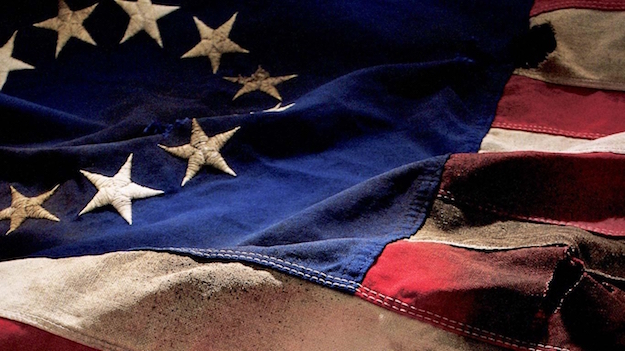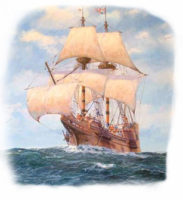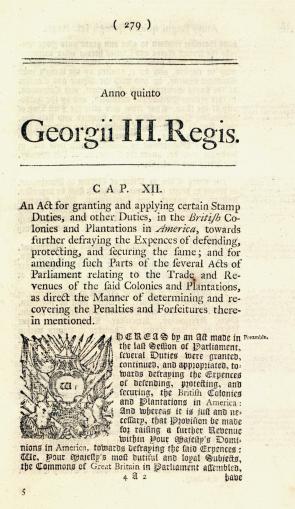 ~ Foreword ~
~ Foreword ~
America, at least as we know it today, is a relative newcomer on the stage as it pertains to the history of what we now call the United States of America. During my travels across the globe I have visited countries whose history dates back thousands of years. I’ve been to Italy; home of the capital of the Roman Empire, (100 B.C.-400 A.D.), and Kuwait which at one time was part of the Babylonian Empire and then later, the Persian Empire. I spent years in Spain, home of Cortez and his Conquistadores, and Korea, whose history dates back to 2300 B.C. So when you compare America to these countries, we are still infants on the world stage.
So when did America as we know it begin? I suppose the answer to that depends upon how you view beginning. I like to look at our nation’s birth along the same parallel as the birth of a child. Conception began when the first batch of Separatists landed at Plymouth in 1620; we went into labor in 1776 and were born in 1873 with the conclusion of the American Revolution.
My goal in writing this is to try and share the history of my/our country from the perspective of one who has gone beyond the dry textbook version I learned in school. I hope to show a different side, or perspective if you will, of the events we all thought we had learned about in our American History classes. American History may not seem important to you as the past is over and done with, so why bother. But Patrick Henry once said, “I know of no way of judging of the future but by the past.” History does tend to repeat itself, especially when the people of an era ignore the lessons to be learned from it.
Plus, as much as I never would have admitted it in my younger years, history can be fun to learn if you approach it with the right attitude. But I also realize it can be boring. Therefore, instead of one long, lengthy article covering the entire history of America, I will break this down into short segments; almost like chapters, to help guide you along and show you our American History as I now see it. ~ Neal Ross
~ Part One ~
To understand how America came into existence one cannot look at the world as it exists today to understand what led those first Pilgrims to flee their homeland to come settle in the untamed wilderness that was the America’s in the early part of the 17th Century. Times were very different 400 year ago than they are today and if you try to view the passage of the Pilgrims across the Atlantic to the New World with 21st century perspectives you will not understand exactly what led them to flee their native lands to face an uncertain future.
At the time the Pilgrims made their way across the Atlantic England was not an absolute monarchy as it had been in times past; instead it was what you might call a monarchial republic with the King at the head, but having a Parliament which consisted of a House of Commons and a House of Lords as well. Whatever shape the government may have taken, the people were still considered subjects and to do almost anything required permission from the Crown, or agents of the Crown.
Although the King did not have the absolute authority he may have had in centuries past, he was still considered to rule by divine right; that is by the Grace of God. The Church itself may have tended to the spiritual needs of the people, but the King ruled in God’s name and had authority over the lives of his subjects.
It was also a time in which state sponsored churches, such as the Church of England, were far more influential than the churches we have spread across our land today. To question them, or practice a faith which ran counter to established beliefs, was to invite persecution. Such was the case for the English Separatists, a branch of English Protestants who were critical of the Church of England.
In the early 1600’s these Separatists fled to Holland to avoid the persecution they lived under in England. Holland was much more tolerant of differing beliefs than was England, and it opened its arms to them. However, the elder Separatists began fearing that their youth were losing their identity and heritage and decided to seek out a location where they could raise their children and practice their religious beliefs as they saw fit.
 Thus it was that in the year 1620, one-hundred-two passengers boarded the aging wooden merchant ship the Mayflower, and left their homes forever to seek a land to live in where they would be free of the religious persecution they had suffered from at home. But it wasn’t as simple as it sounds; they didn’t just go out and hire a ship like one might flag down a taxi. First they had to obtain permission from their government in the form of a charter which granted them permission to establish a settlement in such and such location.
Thus it was that in the year 1620, one-hundred-two passengers boarded the aging wooden merchant ship the Mayflower, and left their homes forever to seek a land to live in where they would be free of the religious persecution they had suffered from at home. But it wasn’t as simple as it sounds; they didn’t just go out and hire a ship like one might flag down a taxi. First they had to obtain permission from their government in the form of a charter which granted them permission to establish a settlement in such and such location.
These charters were basically contracts between the settlers and their government. They could be simple things which granted the settlers the right to establish a colony, or they could be quite detailed; outlining the laws they must adhere to while living outside the homeland, and the responsibilities of the crown for things such as provisions and protection.
Their original plan was to settle in Virginia, at or near an earlier British settlement. However, they arrived at, what is now known as Cape Cod, Massachusetts. They attempted to make their way South, but due to rough seas were forced to set anchor where they had landed. An expedition was sent out in search of a suitable place to establish a settlement, but the winter conditions were so bad that the settlers were forced to spend their first winter aboard the Mayflower. During this time disease, such as influenza and scurvy, claimed the lives of many, and when Spring finally arrived only 53 were left to establish the settlement.
One of the first things they did as settlers was to issue the first official proclamation as subjects of the King on American soil; the Mayflower Compact. This compact states that they realized they were still subjects under their King, at the time King James, and it also stated their purposes for establishing this settlement,
“In the name of God, Amen. We, whose names are underwritten, the loyal subjects of our dread Sovereign Lord King James, by the Grace of God, of Great Britain, France, and Ireland, King, defender of the Faith, etc.”
Having undertaken, for the Glory of God, and advancements of the Christian faith and honor of our King and Country, a voyage to plant the first colony in the Northern parts of Virginia, do by these presents, solemnly and mutually, in the presence of God, and one another, covenant and combine ourselves together into a civil body politic; for our better ordering, and preservation and furtherance of the ends aforesaid; and by virtue hereof to enact, constitute, and frame, such just and equal laws, ordinances, acts, constitutions, and offices, from time to time, as shall be thought most meet and convenient for the general good of the colony; unto which we promise all due submission and obedience.
In witness whereof we have hereunto subscribed our names at Cape Cod the 11th of November, in the year of the reign of our Sovereign Lord King James, of England, France, and Ireland, the eighteenth, and of Scotland the fifty-fourth, 1620.”

Signing of he Mayflower Compact
However, as settlers who were obliged to comply with the terms of the charter which had granted them permission to establish a settlement in the new land, there were certain terms which dictated how they would provide for themselves and store what they produced. One of these terms was that a Common Stock was to be established where food, drink, and all other essentials were to be stored; and then handed out according to the needs of the settlers. Also, all profits, or yields was to be put into this common stock and divided amongst those in the settlement, or Colony.
These terms caused friction in the settlement, as young men refused to work just to see the fruit of their labors going to married men and their families; healthy men refused to work when men unfit for work were given a portion of what they produced; and wives felt it a form of slavery to mend and wash clothing of the single men.
By 1623 things had gotten so bad that they believed that if they did not change something they would soon perish. So Governor Bradford held a meeting and it was decided to abandon this idea of a community stock. Instead, each settler was given their own plot of land and was allowed to keep the goods they produced. Almost immediately they saw an increase in production, and when drought threatened their crops they held a day of fasting and prayer. That night the heavens opened and it rained for days; saving their crops.
Within a year the settlers had done so well that they were able to produce enough to feed themselves, and export a full boatload of corn for profit, which allowed them to pay off their contract and become a truly free market society.
Thus, one of the first lessons we should learn about this earliest period of American history is that socialist ideals do not work; that they lead to class warfare and a decline in production. Only in a free market society can people find the motivation and drive to better their lives by hard work.
~ Part Two ~

The Stamp Act, pamphlet, published in London, 1765. (Gilder Lehrman Collection)
Once word got out that the settlers who arrived at Plymouth in 1620 had established a, somewhat, thriving Colony, more people across Europe began making the decision to seek a new life in the New World. Many of them also sought the same religious freedom which had initially led those aboard the Mayflower to make the voyage across the Atlantic to the New World; others simply sought a chance at a better life in a new land.
Some could not afford the cost of passage across the ocean on their own, yet still wanted to make the journey. What would happen is that a company would front them the price of passage, and upon arriving they would be indentured servants who worked for the company that had funded their crossing until the debt was paid off.
Just looking at the growth of the Plymouth Colony now, in 1621 the Fortune arrived carrying 85 new settlers. In 1622 the Charity and the Swain arrived carrying sixty men to establish a colony north of Plymouth. When it failed they were welcomed into the Plymouth Colony, adding to its population. In 1623 ninety more arrived aboard the Anne and the Little James. The next year the Charity returned, carrying along with more passengers, 3 heifers and a bull, the first of that kind of cattle in the area.
I could go on, but this migration of people continued, until in 1690 there were an estimated 3,055 people living in Plymouth Colony alone; but Plymouth was not the only place people migrated to in the New World.
Others, of differing religious beliefs, began settlements in various places along the Eastern Seaboard. Non-Separatist Anglicans settled in what we now call Virginia. Pennsylvania became home to the Quakers, and the Roman Catholics established a Colony in Maryland. New Amsterdam, or New York as it came to be known, was a hodge podge due to it’s being the center of international trade; with a multitude of differing beliefs living in the same Colony.
It is estimated that by 1700 there were approximately a quarter million people living in the newly established colonies in the Americas; but the English were not alone in colonizing this new land. The French, who were enemies to England at the time, began sending settlers to America as well. The French settlements began in what is now Louisiana and spread outwards and upwards, encompassing what is now Missouri, up into the Great Lakes area, and even into Canada.
Then there was the Spanish colonization as well. Spain established colonies in what is now Florida, and then to the west in parts of what is now Texas and the entire area we now call Arizona and New Mexico, spreading upwards into the lower portions of Utah and Colorado.
It was almost inevitable that there would come a time when these Colonies belonging to warring nations would find themselves fighting each other.
People today are taught that the two great World Wars, both I and II were the first global conflicts, but that is not necessarily true. In 1754 a war broke out which lasted for roughly seven years, which involved many of the great empires of the time. On one side was the English Empire, which included Portugal, Prussia, Hanover, and some small German States, and on the other side was the French Empire which included Austria, Russia, Spain and Sweden. Also, with the help of the French, the Mughal Empire tried to stop a British invasion of Bengal.
So this truly was a world war, although not in the scope of the ones fought later in history. It was therefore inevitable that the conflict would involve the neighboring English and French colonies in the America’s.
The conflict ended and in 1763 the Treaty of Paris was signed in which a complicated series of land exchanges took place; the most important of which saw France ceding Louisiana to Spain and parts of New France to the British.
Yet, as with all wars, two things happen; there is the inevitable loss of life and a destruction of property, and there is the accumulation of debt to fund these wars. Prior to the Seven Years War the Crown had yet to impose any kind of direct tax upon their colonies in America. Yet the King felt that, since his troops had aided the Colonists in defending themselves against the French that they ought to bear part of the burden of paying the costs of having British troops stationed on their soil for their protection.
So, in 1765 Parliament passed The Stamp Act; and in so doing sowed the seeds that would lead to American independence.
…to be continued.
March 7, 2017
~ The Author ~
 Neal Ross, Student of history, politics, patriot and staunch supporter of the 2nd Amendment. Send all comments to: bonsai@syix.com.
Neal Ross, Student of history, politics, patriot and staunch supporter of the 2nd Amendment. Send all comments to: bonsai@syix.com.
If you liked Neal’s latest column, maybe you’ll like his latest booklet: The Civil War: (The Truth You Have Not Been Told) AND don’t forget to pick up your copy of ROSS: Unmasked – An Angry American Speaks Out – and stay tuned – Neal has a new, greatly expanded book coming soon dealing with the harsh truths about the so-called American Civil War of 1861-1865. Life continues to expand for this prolific writer and guardian of TRUE American history.
